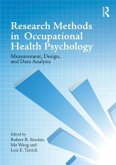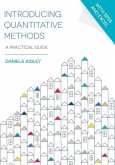Using Co-Production for Physical Activity for Health Research
Herausgeber: Morton, Sarah
Using Co-Production for Physical Activity for Health Research
Herausgeber: Morton, Sarah
- Gebundenes Buch
- Merkliste
- Auf die Merkliste
- Bewerten Bewerten
- Teilen
- Produkt teilen
- Produkterinnerung
- Produkterinnerung
This is the first research methods book on the application of using a co-production approach for physical activity for health research. The authors encourage ongoing innovation and advancement in co-production methodology, and by involving a wide range of stakeholders in research, it provides a bridge between academics and non-academics.
Andere Kunden interessierten sich auch für
![A Step-By-Step Guide to Applying the Rasch Model Using R A Step-By-Step Guide to Applying the Rasch Model Using R]() Iasonas LamprianouA Step-By-Step Guide to Applying the Rasch Model Using R198,99 €
Iasonas LamprianouA Step-By-Step Guide to Applying the Rasch Model Using R198,99 €![Research Methods in Occupational Health Psychology Research Methods in Occupational Health Psychology]() Research Methods in Occupational Health Psychology200,99 €
Research Methods in Occupational Health Psychology200,99 €![Introducing Quantitative Methods Introducing Quantitative Methods]() Daniela AidleyIntroducing Quantitative Methods96,99 €
Daniela AidleyIntroducing Quantitative Methods96,99 €![The Effect of Attendance on Students' Academic Performance. An Empirical Study in Bangladesh The Effect of Attendance on Students' Academic Performance. An Empirical Study in Bangladesh]() AnonymThe Effect of Attendance on Students' Academic Performance. An Empirical Study in Bangladesh17,95 €
AnonymThe Effect of Attendance on Students' Academic Performance. An Empirical Study in Bangladesh17,95 €![Factor Analysis and Related Methods Factor Analysis and Related Methods]() Roderick P McDonaldFactor Analysis and Related Methods200,99 €
Roderick P McDonaldFactor Analysis and Related Methods200,99 €![Models of Society and Complex Systems Models of Society and Complex Systems]() Sebastian IlleModels of Society and Complex Systems176,99 €
Sebastian IlleModels of Society and Complex Systems176,99 €![Longitudinal Multivariate Psychology Longitudinal Multivariate Psychology]() Longitudinal Multivariate Psychology198,99 €
Longitudinal Multivariate Psychology198,99 €-
-
-
This is the first research methods book on the application of using a co-production approach for physical activity for health research. The authors encourage ongoing innovation and advancement in co-production methodology, and by involving a wide range of stakeholders in research, it provides a bridge between academics and non-academics.
Hinweis: Dieser Artikel kann nur an eine deutsche Lieferadresse ausgeliefert werden.
Hinweis: Dieser Artikel kann nur an eine deutsche Lieferadresse ausgeliefert werden.
Produktdetails
- Produktdetails
- Verlag: Taylor & Francis Ltd
- Seitenzahl: 210
- Erscheinungstermin: 13. Juni 2025
- Englisch
- Abmessung: 246mm x 174mm
- ISBN-13: 9781032657172
- ISBN-10: 1032657170
- Artikelnr.: 72655005
- Herstellerkennzeichnung
- Libri GmbH
- Europaallee 1
- 36244 Bad Hersfeld
- gpsr@libri.de
- Verlag: Taylor & Francis Ltd
- Seitenzahl: 210
- Erscheinungstermin: 13. Juni 2025
- Englisch
- Abmessung: 246mm x 174mm
- ISBN-13: 9781032657172
- ISBN-10: 1032657170
- Artikelnr.: 72655005
- Herstellerkennzeichnung
- Libri GmbH
- Europaallee 1
- 36244 Bad Hersfeld
- gpsr@libri.de
Sarah Morton (University of Edinburgh, Scotland) is a Chancellor's Fellow at the Institute of Sport, based at the Physical Activity for Health Research Centre. She is a design engineer and ethnographer, and uses participatory, shared decision making and co-design approaches to develop interventions and strategies to support people to move more.
Author biographies
List of figures
Section 1: Introduction
Chapter 1: Introduction and summary of the book (Morton)
Section 2: Setting the scene
Chapter 2: An introduction to the co-production approach: opportunities and
challenges (Morton)
Chapter 3: Overview of physical activity for health (Morton)
Section 3: Using co-production in physical activity for health research
Chapter 4: Resources for doing co-production (Morton)
Chapter 5: Research Frameworks and Guiding Principles for informing
co-production (Morton)
Chapter 6: Research methods for doing co-production as part of physical
activity for health research (Morton)
Chapter 7: Co-producing mobile health interventions for physical activity
behaviour change (Mair, Castro, and Hashim)
Section 4: Examples in practice
Chapter 8: Co-producing Bradford District's Physical Activity Strategy:
Every Move Counts (Hall, Howells, and Burkhardt)
Chapter 9: The ups and downs of co-producing physical activity research
with ethnic minority adolescent girls in a multi-ethnic UK city (Frazer,
Hall, and Fatima)
Chapter 10: The Journey of Co-Producing 'Movement Matters' - A Physical
Activity and Motor Competence Programme for Children with Intellectual
Disabilities (Taylor and Foweather)
Chapter 11: Working with People with Dementia and Unpaid Carers to
Establish Dementia Friendly Health Walks Within the Scottish Health Walk
Network (Greenwood and Lytham)
Chapter 12: Trialling interventions with Scottish Government employees to
reduce sedentary behaviour while working at home; a project with the
University of Edinburgh (Biesty, Baillie, and Taylor)
Chapter 13: Co-producing awareness raising materials to support Lyme
disease risk mitigation without discouraging activity in outdoors spaces
(Morton and Munoz)
List of figures
Section 1: Introduction
Chapter 1: Introduction and summary of the book (Morton)
Section 2: Setting the scene
Chapter 2: An introduction to the co-production approach: opportunities and
challenges (Morton)
Chapter 3: Overview of physical activity for health (Morton)
Section 3: Using co-production in physical activity for health research
Chapter 4: Resources for doing co-production (Morton)
Chapter 5: Research Frameworks and Guiding Principles for informing
co-production (Morton)
Chapter 6: Research methods for doing co-production as part of physical
activity for health research (Morton)
Chapter 7: Co-producing mobile health interventions for physical activity
behaviour change (Mair, Castro, and Hashim)
Section 4: Examples in practice
Chapter 8: Co-producing Bradford District's Physical Activity Strategy:
Every Move Counts (Hall, Howells, and Burkhardt)
Chapter 9: The ups and downs of co-producing physical activity research
with ethnic minority adolescent girls in a multi-ethnic UK city (Frazer,
Hall, and Fatima)
Chapter 10: The Journey of Co-Producing 'Movement Matters' - A Physical
Activity and Motor Competence Programme for Children with Intellectual
Disabilities (Taylor and Foweather)
Chapter 11: Working with People with Dementia and Unpaid Carers to
Establish Dementia Friendly Health Walks Within the Scottish Health Walk
Network (Greenwood and Lytham)
Chapter 12: Trialling interventions with Scottish Government employees to
reduce sedentary behaviour while working at home; a project with the
University of Edinburgh (Biesty, Baillie, and Taylor)
Chapter 13: Co-producing awareness raising materials to support Lyme
disease risk mitigation without discouraging activity in outdoors spaces
(Morton and Munoz)
Author biographies
List of figures
Section 1: Introduction
Chapter 1: Introduction and summary of the book (Morton)
Section 2: Setting the scene
Chapter 2: An introduction to the co-production approach: opportunities and
challenges (Morton)
Chapter 3: Overview of physical activity for health (Morton)
Section 3: Using co-production in physical activity for health research
Chapter 4: Resources for doing co-production (Morton)
Chapter 5: Research Frameworks and Guiding Principles for informing
co-production (Morton)
Chapter 6: Research methods for doing co-production as part of physical
activity for health research (Morton)
Chapter 7: Co-producing mobile health interventions for physical activity
behaviour change (Mair, Castro, and Hashim)
Section 4: Examples in practice
Chapter 8: Co-producing Bradford District's Physical Activity Strategy:
Every Move Counts (Hall, Howells, and Burkhardt)
Chapter 9: The ups and downs of co-producing physical activity research
with ethnic minority adolescent girls in a multi-ethnic UK city (Frazer,
Hall, and Fatima)
Chapter 10: The Journey of Co-Producing 'Movement Matters' - A Physical
Activity and Motor Competence Programme for Children with Intellectual
Disabilities (Taylor and Foweather)
Chapter 11: Working with People with Dementia and Unpaid Carers to
Establish Dementia Friendly Health Walks Within the Scottish Health Walk
Network (Greenwood and Lytham)
Chapter 12: Trialling interventions with Scottish Government employees to
reduce sedentary behaviour while working at home; a project with the
University of Edinburgh (Biesty, Baillie, and Taylor)
Chapter 13: Co-producing awareness raising materials to support Lyme
disease risk mitigation without discouraging activity in outdoors spaces
(Morton and Munoz)
List of figures
Section 1: Introduction
Chapter 1: Introduction and summary of the book (Morton)
Section 2: Setting the scene
Chapter 2: An introduction to the co-production approach: opportunities and
challenges (Morton)
Chapter 3: Overview of physical activity for health (Morton)
Section 3: Using co-production in physical activity for health research
Chapter 4: Resources for doing co-production (Morton)
Chapter 5: Research Frameworks and Guiding Principles for informing
co-production (Morton)
Chapter 6: Research methods for doing co-production as part of physical
activity for health research (Morton)
Chapter 7: Co-producing mobile health interventions for physical activity
behaviour change (Mair, Castro, and Hashim)
Section 4: Examples in practice
Chapter 8: Co-producing Bradford District's Physical Activity Strategy:
Every Move Counts (Hall, Howells, and Burkhardt)
Chapter 9: The ups and downs of co-producing physical activity research
with ethnic minority adolescent girls in a multi-ethnic UK city (Frazer,
Hall, and Fatima)
Chapter 10: The Journey of Co-Producing 'Movement Matters' - A Physical
Activity and Motor Competence Programme for Children with Intellectual
Disabilities (Taylor and Foweather)
Chapter 11: Working with People with Dementia and Unpaid Carers to
Establish Dementia Friendly Health Walks Within the Scottish Health Walk
Network (Greenwood and Lytham)
Chapter 12: Trialling interventions with Scottish Government employees to
reduce sedentary behaviour while working at home; a project with the
University of Edinburgh (Biesty, Baillie, and Taylor)
Chapter 13: Co-producing awareness raising materials to support Lyme
disease risk mitigation without discouraging activity in outdoors spaces
(Morton and Munoz)








